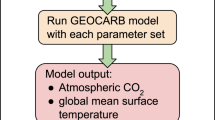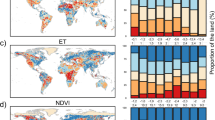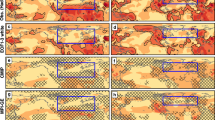Abstract
Radiative forcing is a fundamental quantity for understanding anthropogenic and natural drivers of past and future climate change1, yet significant uncertainty remains in our quantification of radiative forcing and its model representation2,3,4. Here we use instrumental measurements of historical global mean surface temperature change and Earth’s total heat uptake, alongside estimates of the Earth’s radiative response, to provide a top-down energy budget constraint on historical (1861–1880 to near-present) effective radiative forcing of 2.3 W m−2 (1.7–3.0W m−2; 5–95% confidence interval). This represents a near 40% reduction in the 5–95% uncertainty range assessed by the IPCC Fifth Assessment Report2. Although precise estimates of effective radiative forcing in models do not widely exist, our results suggest that the effective radiative forcing may be too small in as many as one-third of climate models in the fifth phase of the Coupled Model Intercomparison Project. Improving model representation of radiative forcing should be a priority for modelling centres. This will reduce uncertainties in climate projections that have persisted for decades4,5.
This is a preview of subscription content, access via your institution
Access options
Access Nature and 54 other Nature Portfolio journals
Get Nature+, our best-value online-access subscription
$29.99 / 30 days
cancel any time
Subscribe to this journal
Receive 12 print issues and online access
$209.00 per year
only $17.42 per issue
Buy this article
- Purchase on Springer Link
- Instant access to full article PDF
Prices may be subject to local taxes which are calculated during checkout

Similar content being viewed by others
Data availability
The Cowtan and Way20 global annual mean temperature anomaly dataset was accessed via https://www-users.york.ac.uk/~kdc3/papers/coverage2013/had4_krig_annual_v2_0_0.txt. All other data supporting the findings of this study are provided and/or referenced within this paper.
Code availability
The code used to produce the energy budget constraint and Fig. 1 is available via the following online repository: https://github.com/timothyandrews/historical-radiative-forcing (ref. 51).
References
Shine, K. P. & Forster, P. M. The effect of human activity on radiative forcing of climate change: a review of recent developments. Glob. Planet. Change 20, 205–225 (1999).
Myhre, G. et al. in Climate Change 2013: The Physical Science Basis (eds Stocker, T. F. et al.) 659–740 (IPCC, Cambridge Univ. Press, 2013).
Forster, P. M. et al. Evaluating adjusted forcing and model spread for historical and future scenarios in the CMIP5 generation of climate models. J. Geophys. Res. 118, 1139–1150 (2013).
Soden, B. J., Collins, W. D. & Feldman, D. R. Reducing uncertainties in climate models. Science 361, 326–327 (2018).
Pincus, R., Forster, P. M. & Stevens, B. The Radiative Forcing Model Intercomparison Project (RFMIP): experimental protocol for CMIP6. Geosci. Model Dev. 9, 3447–3460 (2016).
National Research Council Radiative Forcing of Climate Change (National Academies, 2005).
Sherwood, S. C. et al. Adjustments in the forcing–feedback framework for understanding climate change. Bull. Am. Meteorol. Soc. 96, 217–228 (2015).
Gregory, J. M., Stouffer, R. J., Raper, S. C., Stott, P. A. & Rayner, N. A. An observationally based estimate of the climate sensitivity. J. Clim. 15, 3117–3121 (2002).
Otto., A. et al. Energy budget constraints on climate response. Nat. Geosci. 6, 415–416 (2013).
Forster, P. M. & Taylor, K. E. Climate forcings and climate sensitivities diagnosed from coupled climate model integrations. J. Clim. 19, 6181–6194 (2006).
Andrews, T., Gregory, J. M. & Webb, M. J. The dependence of radiative forcing and feedback on evolving patterns of surface temperature change in climate models. J. Clim. 28, 1630–1648 (2015).
Andrews, T. & Webb, M. J. The dependence of global cloud and lapse rate feedbacks on the spatial structure of tropical pacific warming. J. Clim. 31, 641–654 (2018).
Gregory, J. M. & Andrews, T. Variation in climate sensitivity and feedback parameters during the historical period. Geophys. Res. Lett. 43, 3911–3920 (2016).
Zhou., C., Zelinka, M. D. & Klein, S. A. Impact of decadal cloud variations on the Earth’s energy budget. Nat. Geosci. 9, 871–874 (2016).
Xie, S. P., Kosaka, Y. & Okumura, Y. M. Distinct energy budgets for anthropogenic and natural changes during global warming hiatus. Nat. Geosci. 9, 29–33 (2016).
Dong, Y., Proistosescu, C., Armour, K. C. & Battisti, D. S. Attributing historical and future evolution of radiative feedbacks to regional warming patterns using a Green’s function approach: the preeminence of the western Pacific. J. Clim. 32, 5471–5491 (2019).
Forest, C. E. et al. Quantifying uncertainties in climate system properties with the use of recent climate observations. Science 295, 113–117 (2002).
Richardson, M., Cowtan, K., Hawkins, E. & Stolpe, M. B. Reconciled climate response estimates from climate models and the energy budget of Earth. Nat. Clim. Change 6, 931–935 (2016).
Johnson, G. C., Lyman, J. M. & Loeb, N. G. Improving estimates of Earth’s energy imbalance. Nat. Clim. Change 6, 639–640 (2016).
Cowtan, K. & Way, R. G. Coverage bias in the HadCRUT4 temperature series and its impact on recent temperature trends. Q. J. R. Meteorol. Soc. 140, 1935–1944 (2014).
Forster, P. M. Inference of climate sensitivity from analysis of Earth’s energy budget. Annu. Rev. Earth Planet. Sci. 44, 85–106 (2016).
Andrews, T. et al. Accounting for changing temperature patterns increases historical estimates of climate sensitivity. Geophys. Res. Lett. 45, 8490–8499 (2018).
Hurrell, J. et al. A new sea surface temperature and sea ice boundary dataset for the community atmosphere model. J. Clim. 21, 5145–5153 (2008).
Allan, R. P. et al. Changes in global net radiative imbalance 1985-2012. Geophys. Res. Lett. 41, 5588–5597 (2014).
Smith, D. M. et al. Earth’s energy imbalance since 1960 in observations and CMIP5 models. Geophys. Res. Lett. 42, 1205–1213 (2015).
Ceppi, P. & Gregory, J. M. Relationship of tropospheric stability to climate sensitivity and Earth’s observed radiation budget. Proc. Natl Acad. Sci. USA 114, 13126–13131 (2017).
Stevens, B. Rethinking the lower bound on aerosol radiative forcing. J. Clim. 28, 4794–4819 (2015).
Sato, Y. et al. Aerosol effects on cloud water amounts were successfully simulated by a global cloud-system resolving model. Nat. Commun. 9, 985 (2018).
Zelinka, M. D., Andrews, T., Forster, P. M. & Taylor, K. E. Quantifying components of aerosol–cloud–radiation interactions in climate models. J. Geophys. Res. 119, 7599–7615 (2014).
Toll, V., Christensen, M., Gassó, S. & Bellouin, N. Volcano and ship tracks indicate excessive aerosol‐induced cloud water increases in a climate model. Geophys. Res. Lett. 44, 12492–12500 (2017).
Etminan, M., Myhre, G., Highwood, E. J. & Shine, K. P. Radiative forcing of carbon dioxide, methane, and nitrous oxide: a significant revision of the methane radiative forcing. Geophys. Res. Lett. 43, 12614–12623 (2016).
Andrews, T., Betts, R. A., Booth, B. B. B., Jones, C. D. & Jones, G. S. Effective radiative forcing from historical land-use change. Clim. Dynam. 48, 3489–3505 (2017).
Golaz, J. C. et al. The DOE E3SM coupled model version 1: overview and evaluation at standard resolution. J. Adv. Model. Earth Syst. 11, 2089–2129 (2019).
Kiehl, J. T. Twentieth century climate model response and climate sensitivity. Geophys. Res. Lett. 34, L22710 (2007).
Hegerl, G. & Zwiers, F. Use of models in detection and attribution of climate change. WIREs Clim. Change 2, 570–591 (2011).
Cowtan, K. et al. Robust comparison of climate models with observations using blended land air and ocean sea surface temperatures. Geophys. Res. Lett. 42, 6526–6534 (2015).
Armour, K. C. Energy budget constraints on climate sensitivity in light of inconstant climate feedbacks. Nat. Clim. Change 7, 331–335 (2017).
Lewis, N. & Curry, J. The impact of recent forcing and ocean heat uptake data on estimates of climate sensitivity. J. Clim. 31, 6051–6071 (2018).
Gregory, J. M. Long‐term effect of volcanic forcing on ocean heat content. Geophys. Res. Lett. 37, L22701 (2010).
Dessler, A., Mauritsen, T. & Stevens, B. J. The influence of internal variability on Earth’s energy balance framework and implications for estimating climate sensitivity. Atmos. Chem. Phys. 18, 5147–5155 (2018).
Kang, S. M. & Xie, S. Dependence of climate response on meridional structure of external thermal forcing. J. Clim. 27, 5593–5600 (2014).
Rose, B. E. J., Armour, K. C., Battisti, D. S., Feldl, N. & Koll, D. D. B. The dependence of transient climate sensitivity and radiative feedbacks on the spatial pattern of ocean heat uptake. Geophys. Res. Lett. 41, 1071–1078 (2014).
Rugenstein, M. A. A., Caldeira, K. & Knutti, R. Dependence of global radiative feedbacks on evolving patterns of surface heat fluxes. Geophys. Res. Lett. 43, 9877–9885 (2016).
Marvel, K., Pincus, R., Schmidt, G. A. & Miller, R. L. Internal variability and disequilibrium confound estimates of climate sensitivity from observations. Geophys. Res. Lett. 45, 1595–1601 (2018).
Gregory, J. M., Andrews, T., Ceppi, P., Mauritsen, T. & Webb, M. J. How accurately can the climate sensitivity to CO2 be estimated from historical climate change? Clim. Dynam. 54, 129–157 (2019).
Dessler, A. E. & Forster, P. M. An estimate of equilibrium climate sensitivity from interannual variability. J. Geophys. Res. 123, 8634–8645 (2018).
Schurer, A. P. et al. Importance of the pre-industrial baseline for likelihood of exceeding Paris goals. Nat. Clim. Change 7, 563–567 (2017).
Hawkins et al. Estimating changes in global temperature since the preindustrial period. Bull. Am. Meteorol. Soc. 98, 1841–1856 (2017).
Titchner, H. A. & Rayner, N. A. The Met Office Hadley Centre sea ice and sea surface temperature data set, version 2:1. Sea ice concentrations. J. Geophys. Res. 119, 2864–2889 (2014).
Schneider, A., Flanner, M. & Perket, J. Multidecadal variability in surface albedo feedback across CMIP5 models. Geophys. Res. Lett. 45, 1972–1980 (2018).
Andrews, T. Release of Andrews and Forster (2020, NCC) Code. Zenodo https://doi.org/10.5281/zenodo.3600258 (2020).
Acknowledgements
T.A. was supported by the Met Office Hadley Centre Climate Programme funded by BEIS and Defra. P.M.F. was supported by NERC SMURPHS project NE/N006054/1. Both T.A. and P.M.F. were supported by the European Union’s Horizon 2020 research and innovation programme under grant agreement no. 820829 (CONSTRAIN project). We thank M. Ringer and J. Gregory for useful discussions.
Author information
Authors and Affiliations
Contributions
T.A. and P.M.F. conceived the study. T.A. performed the analysis and wrote the manuscript, with comments from P.M.F.
Corresponding author
Ethics declarations
Competing interests
The authors declare no competing interests.
Additional information
Publisher’s note Springer Nature remains neutral with regard to jurisdictional claims in published maps and institutional affiliations.
Rights and permissions
About this article
Cite this article
Andrews, T., Forster, P.M. Energy budget constraints on historical radiative forcing. Nat. Clim. Chang. 10, 313–316 (2020). https://doi.org/10.1038/s41558-020-0696-1
Received:
Accepted:
Published:
Issue Date:
DOI: https://doi.org/10.1038/s41558-020-0696-1
This article is cited by
-
Anthropogenic forcing and response yield observed positive trend in Earth’s energy imbalance
Nature Communications (2021)
-
Greater committed warming after accounting for the pattern effect
Nature Climate Change (2021)



